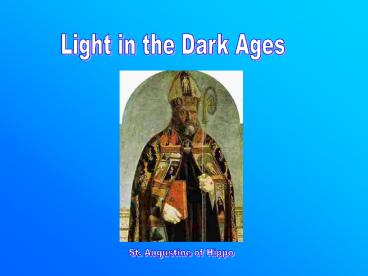Light in the Dark Ages - PowerPoint PPT Presentation
1 / 14
Title:
Light in the Dark Ages
Description:
and Christianity. Ulphilas (Apostle of the Goths) translated the bible into Gothic ... Goths, Burgundians, Lombards, and Vandals were converted to Arian Christianity ... – PowerPoint PPT presentation
Number of Views:78
Avg rating:3.0/5.0
Title: Light in the Dark Ages
1
Light in the Dark Ages
St. Augustine of Hippo
2
Conditions in the Roman Empire during the fifth
century when the empire collapsed
- Germanic invasions had a foreign and violent
influence on Roman culture - Superstition replaced the Greco-Roman tradition
of learning - Literacy and learning declined along with the
economies of nations
3
Ulphilas' influence on the Germanic tribes and
Christianity
- Ulphilas (Apostle of the Goths) translated the
bible into Gothic - As a result of his missionary work, the Goths,
Burgundians, Lombards, and Vandals were converted
to Arian Christianity
4
Key for the Church in converting the Germanic
tribes
- Monasticism was the key!!
5
Germanic invasions change Christian attitude in
the fifth century
- Many Christians believed the Second Coming was
about to take place - Many turned to monasticism to make amends for
sin in the world
6
Christian Monasticism is unique!
- Men and women enter the monastic life in
response to a vocational call - They make a life-long commitment to model
themselves after Christ - They dedicate themselves to a life of prayer and
penance
7
Eremitical life
- The Greek word for desert, eremos, gave this
form of religious living the name eremitic (or
eremitical) life , and the person leading it the
name hermit. - In this life, individuals withdraw into loosely
organized groups to live an isolated life - The Carthusians and the Carmelites are organized
in this way
8
Early Hermits in Egypt
- They sought a life of prayer and secluded
contemplation - They were often interrupted by people asking for
their prayers and guidance
9
Effects of the monasteries on Europe
- The recovery and evangelization of a rural
society as communities of monks and nuns spread
into farming areas to meet the spiritual needs of
the people - The establishment of primary centres of learning
in Western culture. Monks preserved civilization
by preserving and copying ancient Greek and Roman
texts that would certainly have been lost
otherwise - The civilizing of the Germanic peoples by
teaching them farming, trades, and spirituality
10
The Rule of St. Benedict
- The Rule promotes the spirit of peace, love, and
moderation within monastic life - This stands out in contrast to Eastern
asceticism, which often included sleep
deprivation and fasting as a means to spiritual
growth
11
Benedictine vows
- Poverty
- Chastity
- Obedience
12
St. Scholastica
- She was the twin sister of St. Benedict
- She established and governed a convent in
Plombariola, Italy, which followed the
Benedictine Rule
13
Pope St. Gregory I
- He is considered the last of the Latin Doctors
- He marks the beginning of the medieval age,
illustrating the noblest ideals of medieval
Christianity as well as some of the tensions that
would develop in the coming age
14
References
http//en.wikipedia.org/wiki/Consecrated_life_(Cat
holic_Church)The_Eremitic_Life http//images.goo
gle.ca/images?gbv2svnum10hlenqMonasticism
http//www.brusselsjournal.com/files/Invasions_of_
the_Roman_Empi.gif http//www.tucsonmonastery.co
m/images/art/Saint20Scholastica.jpg
http//members.aol.com/kcc1tim/greggr.jpg
http//www.sbcw.org/images/iconben.jpg































